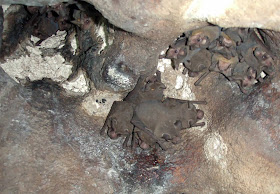 |
| Little Farmers Cay--One of the friendliest and most charming settlements we have visited. |
 |
| Shroud Cay has beautiful mangrove-lined rivers but there's no fishing allowed, which doesn't agree with Matt |
We decided somewhere along the way that we should sail more
and motor less. It may have been around the time that diesel prices went up quite a bit. It hurts to pay
$700 to fill the tanks and generally we have lots of time with no set schedule. It's not that we used
to motor all that much but if winds were light, we would turn on the engines
rather than go 4 knots an hour or slower. For reference, you can probably stroll
faster than that while sporting a slight limp. Nowadays, we will endure 3 or 4
knots or, preferably, will simply wait for better winds if we can.
That's what we're doing at Norman's Cay now--waiting for good
wind and for storms to pass through. We sailed up here from George Town on one
slow day and a couple of fast days. On the slow day, it took us over 6 hours to
sail 20 miles. In contrast, the next day gave us 45 miles in less than 6 hours.
We didn't catch any fish the first day because we were too slow or on the
second day because we were too fast. Just call us Goldilocks.
On our way up, Matt shot some of the Nassau groupers that
were taunting him the last time we were at Leaf Cay because it was a few days
shy of the start of their season. Matt also got a bunch of other fish and a
lobster, most without a spear tip, which somehow fell off after the first fish.
The fishing at Norman's Cay has been pretty sparse. Matt got
a decent sized lionfish. He would have shot another one except that a large
bull shark showed up. Other than that, there is plentiful conch and Matt traded
a beer for a lobster from a thirsty fisherman.
While we wait, Matt is fixing various things. Since we
filled up with fuel in George Town, the galley had been smelling like diesel
and we feared that there was a leak somewhere, which could mean ripping apart
the guts of the boat. Fortunately, Matt discovered that there were several bolts
missing from an attachment point for the tank gauge. If you looked carefully
through one of the screw holes, you could see down into the tank and see diesel
sloshing around. We think maybe the holes used to be blocked with the crud that
falls from the galley (thereby allowing us to not notice it was actually a hole) and became unblocked when we fueled up, allowing fumes to
waft up. While digging through the big box of random screws and bolts, Matt
found a package with 3 bolts that fit perfectly and matched the 2 bolts that
were installed. Why these bolts were apparently purchased
but never put in is but another mystery. After bolting it all up properly, the
smell disappeared.
 |
| Conrad fishing with his bamboo pole spear, just like Dad |



























